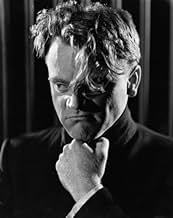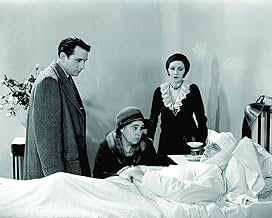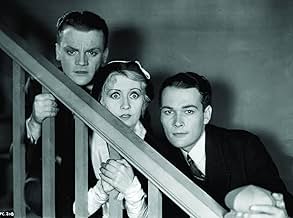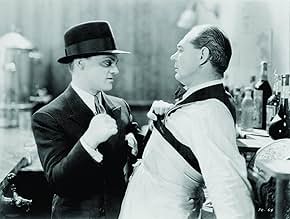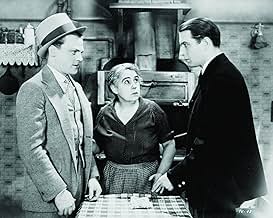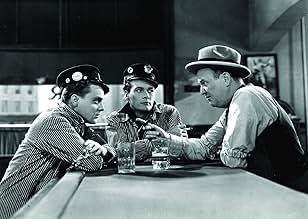Un giovane teppista sale tra le file degli inferi di Chicago, anche se la morte accidentale di un gangster minaccia di scatenare una sanguinosa guerra di mafia.Un giovane teppista sale tra le file degli inferi di Chicago, anche se la morte accidentale di un gangster minaccia di scatenare una sanguinosa guerra di mafia.Un giovane teppista sale tra le file degli inferi di Chicago, anche se la morte accidentale di un gangster minaccia di scatenare una sanguinosa guerra di mafia.
- Regia
- Sceneggiatura
- Star
- Candidato a 1 Oscar
- 1 vittoria e 1 candidatura in totale
- Paddy Ryan
- (as Robert O'Connor)
- Goon
- (non citato nei titoli originali)
- Dutch
- (non citato nei titoli originali)
- Kitty
- (non citato nei titoli originali)
- Tom as a Boy
- (non citato nei titoli originali)
- Machine Gunner
- (non citato nei titoli originali)
- Matt as a Boy
- (non citato nei titoli originali)
- Miller
- (non citato nei titoli originali)
- Molly Doyle
- (non citato nei titoli originali)
- Nails' Girl
- (non citato nei titoli originali)
Recensioni in evidenza
Though "Public Enemy" created the Cagney image, he had already appeared in two other gangsters films for Warners, as a murderer prepared to let someone else pay for his crime in "Sinner's Holiday," and as a double-crossing hoodlum in "Doorway to Hell."
"Public Enemy," however, was a bigger-budget production, directed by William Wellman, and it contained all the elements of success It is the story of two brothers who become Chicago booze barons in the Twenties... One was Cagney, the other Edward Woods
It is sometimes claimed that the story of "Public Enemy" is based on that of "Little Hymie" Weiss, leader of the North Side Chicago gang after the murder of Dion O'Banion by the Capones in 1924 What is more likely is that the Cagney characterization is based on "Little Hymie"; the plot itself is pure fiction
When Cagney, in his striped pajama, sat opposite Mae Clarke at breakfast and decided he had had enough of this boring broad, he wasted no time He picked up half a grapefruit and planted it full into Clarke's face It was a piece of screen action which has lasted down the years as the ultimate in violence from the gangster to his moll
Of course, it isn't it just seems that way Since then gir1s have been slapped, kicked, beaten up, run over, shot, stabbed and raped, all in the tradition of mobster violence
But at the time this scene was daring, and the more daring because it was totally unexpected We remember Mae Clarke in "Public Enemy," yet forget that Jean Harlow was in it, too There may have been good reason The New York Times, reviewing the film in 1934, commented: "The acting throughout is interesting, with the exception of Jean Harlow, who essays the role of a gangster's mistress."
Cagney made violence and a life of crime magically seductive, and "Public Enemy" made him Warners' number 2 gangster, second only to Edward G. Robinson
The film is far from perfect. The first ten minutes of the film in which we are shown a glimpse into the characters' childhood are jerky at best and feel as if much of it was left on the cutting room floor. The movie's incessant fast pace thereafter don't allow for much to sink in, but Cagney saves the day with an absolutely fiery performance. Not one person is spared from his bubbling anger and ferocious delivery.
Finally, the ending will leave you gasping - even by today's standards.
"The Public Enemy" is a must see for any true fan of the mob movie genre.
In my opinion a major credit of the film is that it systematically avoids cliché. Neither Tom nor Matt are outcomes of poverty and social injustice. They come from simple but honest, decent and loving families. But they are both bad (that's the word) and they use the freedom and opportunities of their democratic country to make evil.
In "The Public Enemy" we find probably the first instances of the beautiful stylish cinematography and clever camera-work that will become the trade-mark of later gangster and noir movies. Some scenes are unforgettable, like the final one, or that under the rain, or that of Cagney abusing the girl. The brief scene of the killing of the horse is pure cinematic genius.
In the film there are also some naiveness and clumsiness, though. The way Tom undergoes the personality of his good brother is far-fetched. It is not clear why a gangster in a hospital, wounded in a gun-fight, is not under strict police control. The behavior of Tom's boss in the ending is illogical. Moreover, the part where Tom and Matt are kids is too long (we audience are all eager to see Cagney!), and action is a bit scarce for a gangster movie.
"The Public Enemy" was Cagney's breakout film, and really he makes a powerful and accurate job. Actually, a strong acting is provided by the whole cast. The director William A. Wellmann handles the movie with sound talent.
"The Public Enemy" is a beautiful and historically important movie. I recommend it to any cinema-lover
While we may never literally create a time machine, these old movies give you the miracle of observation at least of what life was once like. Sadly many of the old films have been destroyed through neglect, so the pickings are very slim. Public Enemy is one of the best old movies available. For only the sheer pleasure of seeing what all the fuss was about in Cagney and Harlow, it's worth a viewing. Director Wellman creates some extremely lasting images you won't want to miss, and it almost makes me think of the original Frankenstein for that reason. The final sequence especially is a dramatic example of lasting imagery in film, quite an unforgettable experience. If you like Godfather, Scarface, Goodfellas, and who doesn't, you owe it yourself to watch what may be the patriarch of the entire genre. Interestingly, while the film has a campy disclaimer demonizing the subject matter and mandating public action in order to address the evils of organized crime, it's rather obvious that the producers new exactly what they were really doing by making a film like this. Brutal as some of the action is, Cagney's charisma glorifies the gangster as much as Coppola, Scorsese and all the rest glorify modern organized crime. See it for yourself!!!
Powerful portrait of the rise and fall of a nasty gangster extraordinarily performed by James Cagney
Classic gangster movie contains top-notch performances , unpretentious familiar drama, thrills , fast-paced , action , and a shocking final . Magnificent James Cagney in the title role as a snarling and ominous gangster . Edward Woods was originally hired for the lead role of Tom Powers and James Cagney was hired to play Matt Doyle, his friend . However, once director William A. Wellman got to know both of them and saw Cagney in rehearsals, he realized that Cagney would be far more effective in the star role than Woods, so he switched them . Very good support cast formed by known actresses who subsequently would have an important career as Jean Harlow , Joan Blondell and Mae Clarke including her infamous grapefruit scene that caused women's groups around America to protest the on-screen abuse of Mae Clarke . As several versions exist of the origin of the notorious grapefruit scene, but the most plausible is the one on which James Cagney and Mae Clarke agree: the scene , they explained, was actually staged as a practical joke at the expense of the film crew, just to see their stunned reactions ; there was never any intention of ever using the shot in the completed film , filmmaker Wellman, however, eventually decided to keep the shot, and use it in the film's final release print . Atmospheric and appropriate musical score , Scorsese says that Wellman's use of music in the film influenced his own first gangster picture, Mean Streets (1973) .
Wellman was an expert in all kind of genres as Gangster, drama , Film Noir , Western and adept at comedy as he was at macho material , helming the original ¨ A star is born ¨(1937) (for which he won his only Oscar, for best original story) and the biting satire ¨Nothing sacred¨ (1937) , both of which starred Fredric March for producer David O. Selznick . Both movies were dissections of the fame game, as was his satire ¨Roxie Hart¨ (1942), which reportedly was one of Stanley Kubrick's favorite films. During World War Two Wellman continued to make outstanding films, including ¨Ox-Bow incident¨ (1943) and ¨Story of G.I.Joe¨(1945), and after the war he turned out another war classic, ¨Battleground¨ (1949). In the 1950s Wellman's best later films starred John Wayne, including the influential aviation picture ¨The hight and the mighty¨ (1954), for which he achieved his third and last best director Oscar nomination. His final film hearkened back to his World War One service, ¨The Lafayette squadron¨ (1958), which featured the unit in which Wellman had flown . He retired as a director after making the film, reportedly enraged at Warner Bros.' post-production tampering with a movie that meant so much to him .
¨The Public enemy¨ , rating : Well worth watching , above average ; the picture will appeal to classic cinema buffs and James Cagney fans . It ranked #8 on the American Film Institute's list of the 10 greatest films in the genre "Gangster" .
Lo sapevi?
- QuizOn the set one day, James Cagney stared at Jean Harlow's nipples and asked, likely in perfect innocence and good humor, "How do you keep those things up?" "I ice them," Harlow said, before trotting off to her dressing room to do just that.
- BlooperIn 1915, when Tom meets Putty Nose at the pool hall, the sign on the wall says "Don't spit of the floor. Remember the Jamestown Flood". It was the city of Johnstown, not Jamestown than had the historic flood.
- Citazioni
Tom Powers: [Tom shuffles to the breakfast table in his pajamas. He's just finished a demanding call with Nails Nathan] Ain't you got a drink in the house?
Kitty: Well, not before breakfast, dear.
Tom Powers: [immediately annoyed] ... I didn't ask you for any lip. I asked you if you had a drink.
Kitty: [sheepishly] I know Tom, but I, I wish that...
Tom Powers: ... there you go with that wishin' stuff again. I wish you was a wishing well. So that I could tie a bucket to ya and sink ya.
Kitty: Well, maybe you've found someone you like better.
[Angered, Tom grimaces and shoves a piece of grapefruit in her face as he leaves the table.]
- Curiosità sui creditiIt is the ambition of the authors of "The Public Enemy" to honestly depict the environment that exists today in a certain strata of American life, rather than glorify the hoodlum or the criminal. While the story of "The Public Enemy" is essentially a true story, all names and characters appearing herein, are purely fictional.
- Versioni alternativeFor a 1941 re-release, three scenes in "The Public Enemy" were censored to comply with the Production Code. These censored segments (including an extended edit of the scene involving the gay tailor) were restored for the 2005 DVD release.
- ConnessioniEdited into Three on a Match (1932)
- Colonne sonoreI'm Forever Blowing Bubbles
(1919) (uncredited)
Music by James Kendis, James Brockman and Nat Vincent
Played at various times throughout the film
I più visti
Dettagli
- Data di uscita
- Paese di origine
- Sito ufficiale
- Lingua
- Celebre anche come
- El enemigo público
- Luoghi delle riprese
- Wilshire Blvd, Los Angeles, California, Stati Uniti(convertible ride with Jean Harlow)
- Azienda produttrice
- Vedi altri crediti dell’azienda su IMDbPro
Botteghino
- Lordo Stati Uniti e Canada
- 1.011.520 USD
- Lordo in tutto il mondo
- 1.214.260 USD
- Tempo di esecuzione
- 1h 23min(83 min)
- Colore
- Proporzioni
- 1.37 : 1


